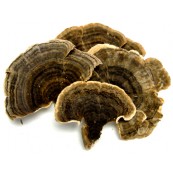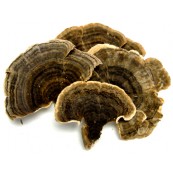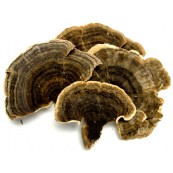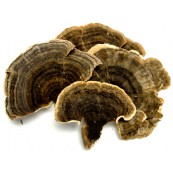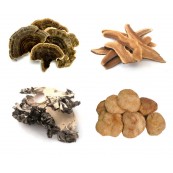|
Cooking Ideas
The easiest to access the medicine of turkey tails is by boiling. The recipe, known as Turkey Tail Tea, is easy – just throw a handfull of Turkey Tail mushrooms into a crock pot and let simmer for 48-72 hours. After that point the good medicines are released. Just get a cup and drink!
|
|
Health Benefits
-
In Traditional Chinese Medicine, Turkey Tail is used to clear dampness, reduce phlegm, heal pulmonary disorders, strengthen the physique, increase energy and benefit people with chronic diseases (Yang & Yong, 1989, Ying et al., 1987). Chinese medical doctors consider it a useful treatment for infection and/or inflammation of the upper respiratory, urinary and digestive tracts. Turkey Tail is also regarded as curative to liver ailments (including hepatitis B and chronic active hepatitis) and is used to treat general weakness of the immune system (Ying et al., 1987)
-
Krestin (PSK), a proprietary anticancer drug approved in Japan, is extracted from the Turkey Tail mushroom and accounted for 25.2% of the total Japanese national expenditure for anticancer agents. Nakazato et al. (1994), reported that 262 gastric cancer patients treated with PSK as an adjunct to chemotherapy showed a decrease in cancer reoccurrence and a significant increase in disease-free survival rate. Kobayashi et al. (1995) reported that the protein-bound polysaccharide PSK reduced cancer metastasis. Sakagami et al. (1993) reported that PSK stimluted interleukin-1 and interferon production in human cells. Other researchers have reported that PSK appears to be a scavenger of free-radical oxidizing compounds. Unlike many conventional anticancer drugs, PSK produces few, if any, side effects and shows no immunosuppressive activity.
-
PSP, a water soluble, low-cytotoxic polysaccharidepeptide appears to induce cytokine production and T-cell proliferation. Collins and Ng (1997) based on an in vitro study proposed the use of PSP as an antiviral agent for the inhibition of HIV replication. In a controlled clinical trial of 485 cancer patients (211 control patients) with cancers of the esophagus, stomach and spleen; treatment with PSP in combination with radio- and chemo-therapies was investigated. In the PSP group, the side effects from the conventional therapies (pain, poor apetite, fatigue, weakness, dryness of throat and mouth) was significantly lessened and body weight, T-cell ratios, NK cell activity and IL-2 levels were significantly increased. PSP also raised the one year survival rate of esophageal cancer patients by 11% and significantly increased remission rates when compared with conventional chemotherapy treatments.
-
The medicinally active components of Turkey Tail are considered to be biological response modifiers which induce immune responses including the increased production of gamma interferon, interleukin-2 and T-cells.
-
The Latin name is Trametes versicolor, which means thin (trametes) and many colored (versicolor). In Chinese medicine it is referred to as yun zhi, and the Japanese name is kawaratake.
-
For other identifying characteristics, know that they have no stem, groups of thin caps with concentric zones of varying colors, and a spore print that ranges from whitish to yellowish.
-
This is a mushroom for all seasons! They're common from spring until fall, and you can sometimes even find them in the winter.
Disclaimer: The information provided within this site is intended for information purposes only and is not intended as a substitute for advice from a physician or other health care professional and should not be used for the diagnosis or treatment of any health problem or for prescription of any medication or other treatment. Taking natural products should be a decision based upon personal research and the advice of health care professionals and be based upon a thorough understanding of the role food-derived medicinally-active compounds play in health and wellbeing. A health care professional should be consulted before taking any medication, or if you have or suspect you might have a health problem. Do not discontinue any other medical treatments without first consulting your doctor.
|
|
Directions on how to Rehydrate
To rehydrate or reconstitute dried mushrooms, place desired amount into a bowl covered with warm water and let dried mushrooms soak for 30 minutes. After the 30 minutes have gone by, gently lift the mushrooms out of the water using a strainer. The mushrooms should be clean, plumped and ready to use.
|
|
How to Store
It is very important that dried mushrooms are stored properly to insure long term and maximum freshness. Turkey tail mushroom generally stays potent for many years, regardless of its form. The constituents don't break down easily. Place the mushrooms into either a plastic or glass container with a tight fitting lid and keep it away from heat and light to extend its useful shelf life. Our first recommendation, though, is freezing or storing in a refrigerator or freezer. Place the dried mushrooms in a clean, tight sealing freezer bag. The reason for maximum cold storage is because heat and moisture are the greatest enemies. The mushrooms should keep well for six months to a year.
|
